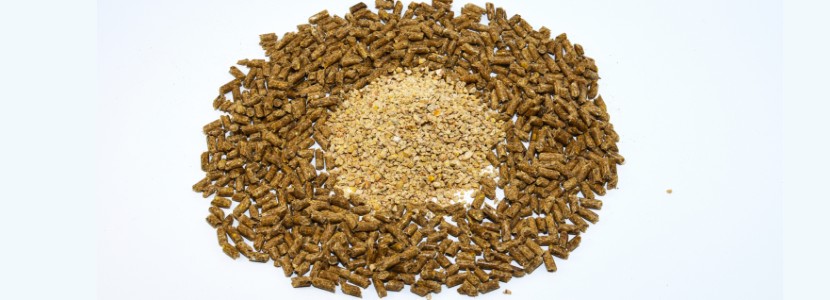Feed formulation for poultry and pigs consists of calculating the different amounts of necessary raw materials to create balanced diets that meet the nutritional requirements of animals.
Due to the fact that feed costs account for two-thirds or more of the total costs in pig and poultry production, special attention is given to feed formulation.
There are different strategies available for food formulation, most of which have to do with a combination of energy and protein requirements, including the digestibility of amino acids.
The presence of indigestible components in raw materials and the use of exogenous enzymes to improve digestibility are also factors that must be taken into account in feed formulation.
- In some cases, feed formulation also includes strategies to reduce nitrogen and phosphorus emissions, in an attempt to minimize the environmental impacts of the pig and poultry industries.
The raw materials which are most commonly used as energy sources in pig and poultry diets are:
- Corn
- Sorghum
- Wheat
- Oats
- Barley
- Rice
- Millet
- By-products from cereal industrialization
These compounds also provide proteins, minerals and vitamins, but their mainly used as energy sources. Raw materials used as energy sources are the main component of diets, reaching up to 99% in ducks and geese during force-feeding (Arroyo et al., 2016).
Cereal grains are the main contributors, but the types of cereal grains used in animal diets, depend largely on their costs and their local availability.
Older sorghum varieties contained high levels of tannin (>1%), limiting digestibility and use. Varieties with low tannin content (<0.5%) have between 90% and 95% of the energy value of corn.
Physical treatment and enzymes can enhance the use of sorghum in bird diets.
Low-tannin sorghum can be used freely in pig diets, while sorghum with high levels of tannins should be used in gradual amounts. Starting from 5% in piglets and lactating sows and reaching up to 20% in the later stages of fattening and for pregnant sows (Tokach et al., 2015].
For piglets with body weights below 10kg, it is advisable to just use low-tannin sorghum and never exceed 50% of the total cereal content.
Pigs fed barley-based diets tend to have a higher feed intake to compensate for barley’s lower energy content compared to that of corn-based diets (Sullivan et al., 2005).
Physical treatment or enzyme supplementation can be used to increase the amount of barley that can be incorporated in bird diets.
The use of oats in bird diets is limited: Naked oats have been used successfully in levels of up to 30% of laying hen diets, replacing corn, soybean meal and oil (Cave et al. , 1989)
Rice processing improves feed digestibility and the productive performance of pigs (Asyifah et al., 2011).
Cereal by-products (rice bran, corn gluten feed, wheat feed, confectionery products, distillery by-products and other cereal by-products) are increasingly used in animal feed. These compounds are usually rich in fiber and have a low energy content. Due to this, their use in poultry feed is limited .
- Its incorporation rate can reach 10-15% in some poultry diets and 30% in pigs (Stein and Shurson, 2009).
Fats are a highly concentrated form of energy, but their inclusion as real fats or oils is limited to 2%-5% of the diet due to their high costs and the risk of rancidity during long-term storage.
Protein sources
Proteins, are the second most important component of poultry and pig diets. Amino acid supplementation is usually carried out in order to complete diets.
Soybean meal is the preferred protein source for pig and poultry feeding, as it contains between 40% and 50% crude protein, depending on the amount of husks removed and the oil extraction procedure used.
Rapeseed and canola meals are by-products of oil extraction that can be used as protein sources in animal nutrition. Rapeseed meal has a lower nutritional value than soybean meal because of its lower protein content, higher crude fiber content, and because it contains antinutrients such as glucosinolates and erucic acid.
The use of rapeseed meal as a substitute for soybean meal is limited in pigs and poultry to less than 1% of diets (Wu, 2014). Canola was created in the 1970s through plant crossing to remove glucosinolates and erucic acid from rapeseed.
- Recent literature reviews suggest that yield is affected when more than 50% of soybean meal is replaced by canola meal in pig and poultry diets(Khajali and Slominski, 2012).
Sunflower meal is also a by-product of oil extraction. It contains 29%-30% protein, 27%-31% crude fiber and 9%-12% lignin (Lomascolo et al. , 2012). Replacing soybean meal with sunflower meal at high rates is possible in different poultry species (Jankowski et al., 2012) and can also be used in pig feed, although some studies suggest that the digestibility of amino acids was lower than in soybean meal (Gonzalez-Vega et al., 2012).
Cottonseed flour is a rich source of protein (20% to 56%) and metabolizable energy that is commonly used for animal feed.
- However, its use in diets for pigs and poultry is limited by the presence of toxic compounds such as gossypol, in addition to high fiber and low-quality protein content.
No detrimental effect on broiler performance was found when cottonseed flour was used to replace up to 20% of soybean meal in diets (Batonon-Alavo et al., 2015).
Animal protein ingredients, such as dehydrated whey and fishmeal, can be used to balance dietary amino acid content, especially for young animals whose amino acid requirements are high.
- However, due to its high prices, its incorporation rate is usually low (Ravindran, 2013).
This entry aims to make a review on current pig and poultry feed formulation and what are some of the main raw materials used for such purpose. Emphasizing the need to continue exploring different potential ingredients that can offer real nutritional value as well as representing cost effective alternatives.
